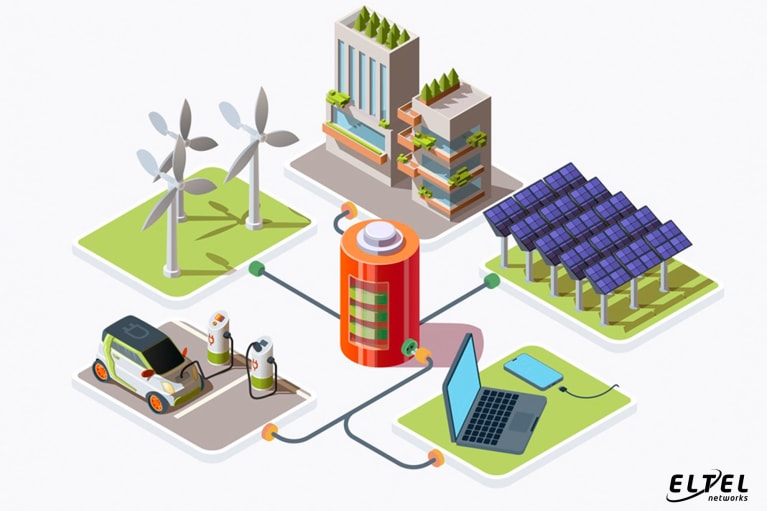
Smart Grid technology
Power grid design is a demanding and very complex process. Nowadays it requires not only to meet all formal and legal requirements, but also to apply new solutions and use modern technologies. In this context, you may encounter the term "Smart Grid technology". What is a Smart Grid and what is modern power network design?
What is Smart Grid technology?
At its simplest translation, the term "Smart Grid" is simply a smart power network. Taking the definition of a grid as "interconnected and cooperating installations for the transmission or distribution of electricity, belonging to an electric entity or distribution company," we need to add the element of "smart," that is, this intelligence, to get a Smart Grid. What does it consist of?
In the case of power networks, this means the use of solutions in its design that allow communication between its individual components. This communication is aimed at integrating the activities of the network parties: producers, consumers and distributors of electricity. It is possible thanks to the use of modern technological solutions, e.g. IT systems monitoring and managing individual aspects (e.g. possible emergency shutdowns, power flows - also in the case of wind farms, photovoltaic cells connected to the grid, voltage regulation, etc.), databases exchanging information, advanced measurement equipment and smart meters, analytical modules, etc.
Therefore, an intelligent energy network consists of many elements, including not only the infrastructure (cable line, energy storage, transformers, substations, switchgear, etc.), but also, and perhaps most important, the various IT and telecommunications solutions used at various levels. Market participants are also an integral part of a modern grid, because one of the aspects of Smart Grid is also the regulation of energy use.
Smart Grid power network design - why is it so important?
The Smart Grid is intended to contribute to better use of energy and a reduction in overall energy consumption, lower network losses, increased network security and quality of supply, faster detection of possible failures, and even lower costs of energy use for consumers. It is also intended to allow the transition from a centralized system of energy production and supply based on a few large generators to a more distributed system incorporating smaller generating units, including by providing technical conditions for the connection of renewable energy sources (RES). In this way, Smart Grid technology makes it possible to increase the level of flexibility of the power grid and optimize resource consumption, as well as energy supply and demand.
Implementing smart grids is now a necessity due to the ever-increasing demand for energy. With constraints hampering the rapid development of infrastructure, one way to deal with this challenge is to modernize it and make better use of available resources. This can be achieved precisely by, among other things, the use of modern devices that improve transmission capabilities, smart transformers or software that allows remote reading, reporting and reconfiguration of the grid.
On a macro level, the implementation of Smart Grid solutions also has an impact on increasing the country's energy security. It influences resource efficiency, energy storage, increases independence in energy production by increasing the level of use of renewable energy sources, and thus contributes to reducing the negative impact of the energy sector on the environment. As can be seen, smart grids therefore have a significant impact on the functioning of the entire economy.

Smart Grid in power network design
Smart power grids from the perspective of individual consumers
What impact does the development of smart power grids have on individual consumers? From the consumers' perspective, one of the benefits is easier billing of energy consumption. The use of intelligent measuring devices allows for settlement of actual consumption, not according to forecasts. Smart Grid also allows you to optimally plan energy use thanks to current access to information about consumption. Therefore, the consumer can plan to use specific devices (such as a car charger) at specific times of the day to benefit from preferential tariffs. Moreover, thanks to the use of Smart Grid, it is possible to introduce modern solutions in the area of settlements, which allows for even better shaping of the demand and supply sides.
Of course, the fact that the use of modern solutions is intended to contribute to increasing the security and stability of the network is also important from the recipients' perspective. The possibility of faster detection and removal of possible failures, reducing the load on the network through better balancing and its increased flexibility or a greater level of use of renewable energy sources may translate into easier assurance of continuity of energy supply.
From a cost perspective, it is also important for the recipient to be able to connect their own micro-energy sources to the network, making the recipient become a prosumer. We are talking about solutions such as photovoltaic panels or home wind farms. This allows you to reduce your individual energy needs. Moreover, in this context, smart power grids allow for load management to increase network efficiency and minimize the risk of unstable network conditions.
Smart Grid – network of the future
Facing of the growing energy demand, the need to find solutions that are more beneficial to the environment or from the perspective of economic security, the development of Smart Grid technology is the answer to many challenges in the energy sector. It allows more efficient use of raw materials, and the implementation of smart grids benefits both individual consumers and the entire economy.
